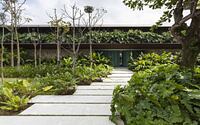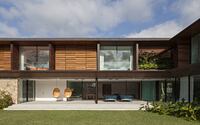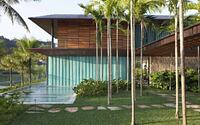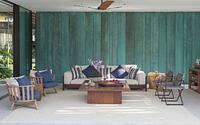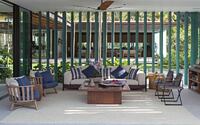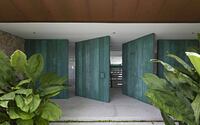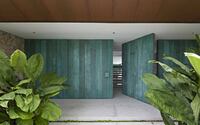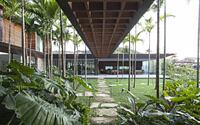CM House by Bernardes Arquitetura
CM House is a leisure retreat in a residential condominium in Paraty, Rio de Janeiro, Brazil, designed in 2015 by Bernardes Arquitetura.









Description
Designed as a leisure retreat in a residential condominium in Paraty, Rio de Janeiro, CM House was created taking into account the land’s visuals and integration with the landscaping.
Set back from the street, the front portion gives way to a dense garden. Rectangular plates in White Siena granite juxtaposed irregularly on the lawn create a sinuous design that leads residents inside. On the sides, different species of philodendrons and medium-sized trees make up the space designed in partnership with Isabel Duprat.
Seeking to ensure privacy for residents, the façade of the house receives an opaque lower gable covered in Moledo stone. Above it, the upper volume, in a steel structure with an enveloped tray in corten steel, accommodates a linear flowerbed made up of medium-sized plant species, which protects the interior. The access to the residence is through pivoting doors with greenish copper sheets, resulting from the chemical oxidation process of the material.
With more than a thousand square meters divided into two floors, the project was designed as a veranda-house, and despite the large area, the implementation with an F design, integrated into the garden rich in textures – natural and materials – ensures comfort in everyday life of the residents.
The first wing, parallel to the street, is a larger volume, and concentrates on the ground floor the entrance hall to the center, service spaces to the left (dining room, pantry, kitchen, laundry, living and service bedroom), and leisure spaces on the right (veranda, children’s room, home theater and a guest suite). On the upper floor, for the intimate areas, in the first portion, there are two suites (one with two beds and the second with three) and at the end, a service staircase, while in the second portion there are three suites (one with two beds and two double suites, the one at the end with an L-shaped design and private balcony).
All bedrooms have panel closures with shutters and bifold windows opening in cumaru wood protected by eaves, which provide privacy and natural ventilation. They also receive floor to ceiling glass sheets and a guardrail.
In the second wing, which crosses the main and continuous volume of the staircase perpendicularly, are the living room and gourmet space on the ground floor, while on the upper floor, two suites, the main one at the end: the master suite with individual bathrooms for the couple and closet. The third wing, to the left of the second and with only one floor, concentrates the main gourmet area that accommodates up to 23 people seated, toilet and gym.
A laminated wood marquee attached directly to steel beams and covered by glass connects these last two volumes. This solution allowed the structure to be free of pillars. Sideways, a set of coconut trees and shrubs in the landscaping create rhythm and perspective for the promenade.
The swimming pool with a lane of more than forty linear meters, was placed visually connecting to the condominium lake. It is worth noting that the smaller gourmet veranda partially invades the pool, and receives greenish vertical brises-soleil, in oxidized copper, in harmony with the color palette of water and vegetation.
In the interiors, natural materials predominate, as well as the facades and furniture in wood and straw that bring the coastal atmosphere, such as the Atibaia chair by Paulo Alves, rocking armchairs by Nanna Ditzel, Gervasoni armchair by Paola Navone and sofas by Paola Lenti. The curtains are in linen and sisal rugs, the decorative objects in rattan and wicker.
With a steel structure and closures in prefabricated elements, the construction had reduced time, since it partially became an assembly system; and higher quality of parts.
Photography by Ruy Teixeira
Visit Bernardes Arquitetura
- by Matt Watts